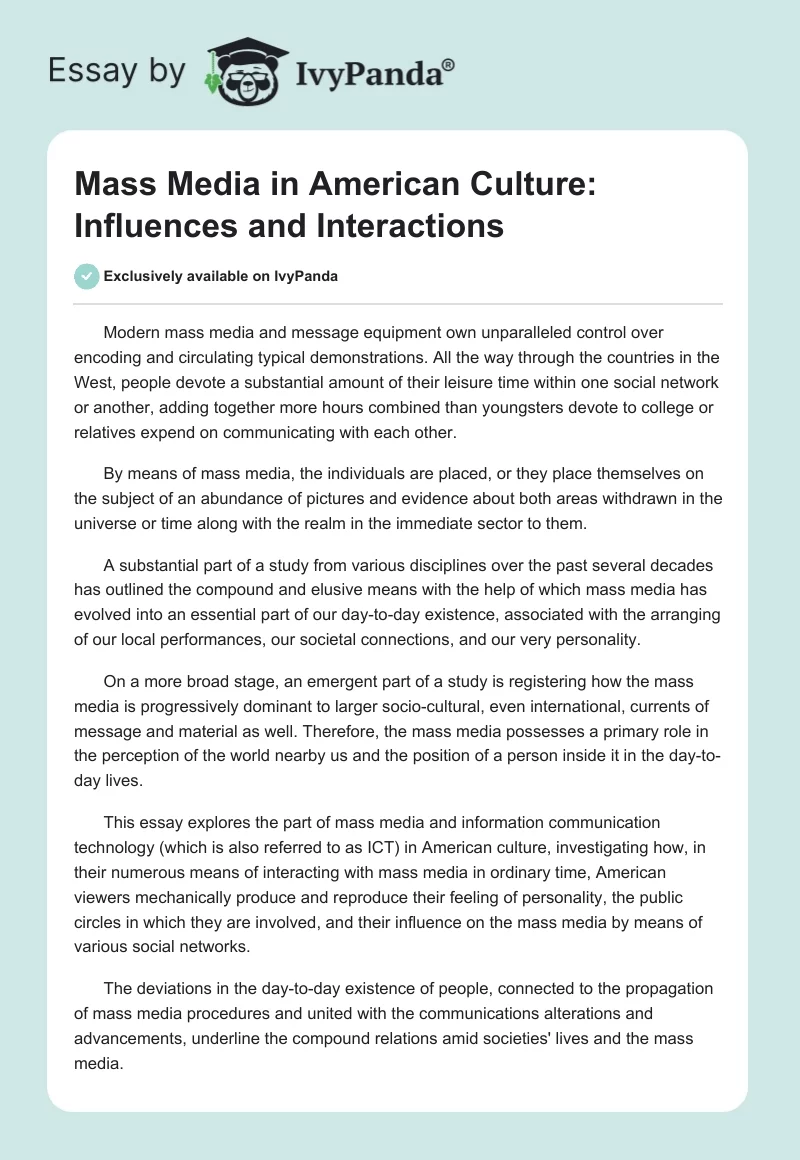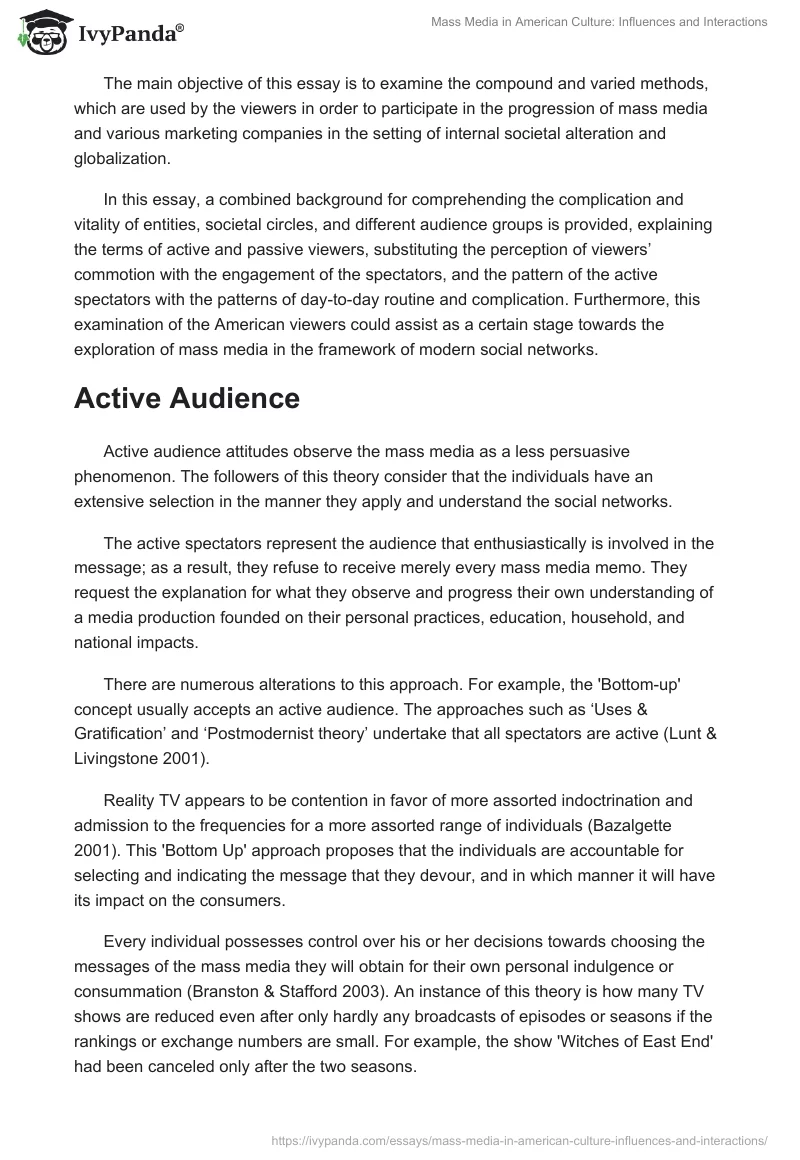Modern mass media and message equipment own unparalleled control over encoding and circulating typical demonstrations. All the way through the countries in the West, people devote a substantial amount of their leisure time within one social network or another, adding together more hours combined than youngsters devote to college or relatives expend on communicating with each other.
By means of mass media, the individuals are placed, or they place themselves on the subject of an abundance of pictures and evidence about both areas withdrawn in the universe or time along with the realm in the immediate sector to them.
A substantial part of a study from various disciplines over the past several decades has outlined the compound and elusive means with the help of which mass media has evolved into an essential part of our day-to-day existence, associated with the arranging of our local performances, our societal connections, and our very personality.
On a more broad stage, an emergent part of a study is registering how the mass media is progressively dominant to larger socio-cultural, even international, currents of message and material as well. Therefore, the mass media possesses a primary role in the perception of the world nearby us and the position of a person inside it in the day-to-day lives.
This essay explores the part of mass media and information communication technology (which is also referred to as ICT) in American culture, investigating how, in their numerous means of interacting with mass media in ordinary time, American viewers mechanically produce and reproduce their feeling of personality, the public circles in which they are involved, and their influence on the mass media by means of various social networks.
The deviations in the day-to-day existence of people, connected to the propagation of mass media procedures and united with the communications alterations and advancements, underline the compound relations amid societies’ lives and the mass media.
The main objective of this essay is to examine the compound and varied methods, which are used by the viewers in order to participate in the progression of mass media and various marketing companies in the setting of internal societal alteration and globalization.
In this essay, a combined background for comprehending the complication and vitality of entities, societal circles, and different audience groups is provided, explaining the terms of active and passive viewers, substituting the perception of viewers’ commotion with the engagement of the spectators, and the pattern of the active spectators with the patterns of day-to-day routine and complication. Furthermore, this examination of the American viewers could assist as a certain stage towards the exploration of mass media in the framework of modern social networks.
Active Audience
Active audience attitudes observe the mass media as a less persuasive phenomenon. The followers of this theory consider that the individuals have an extensive selection in the manner they apply and understand the social networks.
The active spectators represent the audience that enthusiastically is involved in the message; as a result, they refuse to receive merely every mass media memo. They request the explanation for what they observe and progress their own understanding of a media production founded on their personal practices, education, household, and national impacts.
There are numerous alterations to this approach. For example, the ‘Bottom-up’ concept usually accepts an active audience. The approaches such as ‘Uses & Gratification’ and ‘Postmodernist theory’ undertake that all spectators are active (Lunt & Livingstone 2001).
Reality TV appears to be contention in favor of more assorted indoctrination and admission to the frequencies for a more assorted range of individuals (Bazalgette 2001). This ‘Bottom Up’ approach proposes that the individuals are accountable for selecting and indicating the message that they devour, and in which manner it will have its impact on the consumers.
Every individual possesses control over his or her decisions towards choosing the messages of the mass media they will obtain for their own personal indulgence or consummation (Branston & Stafford 2003). An instance of this theory is how many TV shows are reduced even after only hardly any broadcasts of episodes or seasons if the rankings or exchange numbers are small. For example, the show ‘Witches of East End’ had been canceled only after the two seasons.
Nonetheless afterward, its annulment, the admirers of the show started an online order movement in order to protect the show named ‘Renew Witches of East End.’ The movement gained a lot of popularity on Twitter, where the followers were stated to apply “the hashtag #RenewWitchesofEastEnd and send it to the Twitter of the network.
The example of this show is a clear indication that the social order regulates the message that they obtain. Fans are viewers who speak back to the systems and the creators, and they are aware of how to organize the lobby in the best interests of the threatened shows (Jenkins 1992). Spectators’ affiliates can end the consummation of certain media messages by merely switching the TV set off, or, in contrast, try to save the message of mass media by implementing the active actions.
Moreover, it is worth pointing out that the active viewers can reconstruct a definite appearance of a specific personality of a movie or a TV show for various occasions and contribute to the images on Instagram or other social networks; thus increasing the awareness about the show and promoting it by means of mass media. Nevertheless, the fault of this approach is that it undertakes the media has almost no effect at all on a person.
Passive audience
The development of the media surroundings has resulted in doubts that social networks’ users will be exposed to pictures and concepts considered to be detrimental or else unwanted against their will and accidentally as well. For example, Twitter is gaining more and more popularity every day, becoming the source of communication for youngsters and adults.
The users of Twitter currently apply the symbol of the hashtag, or #, in order to refer to any specific subject in their messages. For instance, the popular live show ‘America’s Got Talent’ is broadly discussed by the users of Twitter with the help of various hashtags, such as #adt, #americasgottalent, #voteAGT, etc. By means of these hashtags, the active users of Twitter limit their publications for passive users, revealing the information or, conversely, filtrating it.
Consequently, in conjunction with the sustenance for the active viewers, the model of media has established itself as a counter-practice of the passive part of the viewers. Supporters of this more negative opinion have appealed that the spectators obtain an unwanted impact from the excessively influential mass media. The assessment of ‘the traditional productions’ by the Frankfurt School signified this more negative approach, in the same way, the Schiller’s model of ‘media imperialism’ and Gerbner’s refinement concept did (Livingstone 1998).
The passive viewers do not energetically participate in the framework of a media message. The passive viewers do not have the desire to request the explanation for the memorandum of the mass media and merely receive the memo in the manner the mass media channel envisioned. The ‘Top-Down’ approach towards television impact inclines to undertake that all viewers are passive.
Case Study
Pepsi Challenge
Several months ago the fresh style of the Pepsi Challenge had been represented to the broad audience, in which the trademark is presenting the customers with the astonishing chance to re-imagine the can of the beverage with their own proposals in the ‘Live For Now’ Design Challenge, rendering to a PepsiCo media announcement.
The organization has been encouraging a wide amount of ethnically pertinent, digitally adapted to the inventiveness within the Challenge for the rest of 2015, ever since it produced a restoration of the signature design of its old movement at the beginning of the year.
The deliberate design of the Pepsi bottle contest trails the Pepsi ‘Ignite the Light’ journey (Buss 2015), where the worldwide famous trendy creator and inventive executive Nicola Formichetti, the same artist who gained his popularity as the personal inventor who assisted Lady Gaga in obtaining her avowed glory, was stimulating the active audience to project art performance stimulated by light.
Along with PepsiCo’s commercial assurance to perform with determination, the movement has a pro-societal constituent. By applying the hashtag #PepsiChallenge by the active audience in Twitter, the campaign will also activate a one-dollar payment by the corporation to Liter of Light as well, which, in its turn, will assist in bringing ecologically-responsive, cheap and easy-to-create lights in the underdeveloped countries.
Formichetti is controlling the responsibility to encourage all consumers, not just inventors and originators, to present their own projects for a clean Pepsi can online, with the only condition that the trademark has to remain untouched. “Prosumers work completely for free” (Fuchs 2014, p. 111); therefore, the campaign gained the needed success.
Pepsi accepted the suggestions until May of 2015, and after that, an arbitrating board that contains PepsiCo’s principal project manager Mauro Porcini would have helped to define the most appealing can project.
Personal Opinion
In my personal opinion, from the societal and emotional viewpoint, cultural researches move the people away from queries of insolences towards the impacts of mass media subjects. Both methods of receiving the message that was listed above indirectly interpret the media script as an incitement toward requests of the context-reliant representative movement that is involved by the viewers.
Moreover, individual connections and discussions with the loved ones, such as family relatives, groups, educators, are the occasion of the individuals adapting or declining mass media messages. It could be claimed that social networks are typically crushed by estimation frontrunners, which are represented by the people of inspiration; their opinion and judgments have an impact on their followers.
These leaders frequently express strong concepts towards a wide assortment of subjects. In addition, these estimation leaders uncover themselves to various kinds of mass media and produce a judgment on their essence. Other associates of their societal group then accept these versions. As a result, the active users of social networks and viewers of various shows represent better qualities than the passive audience.
Bibliography
Bazalgette, P 2001, Big brother and beyond, Television.
Branston, G & Stafford, R 2003, The media student’s book, Psychology Press, London.
Buss, D 2015, Pepsi challenge 2015: Nicola Formichetti kicks off can design contest, Web.
Fuchs, C 2014, The political economy of Google, Uppsala University, Uppsala.
Jenkins, H 1992, Textual poachers: Television fans & participatory culture, Routledge, New York.
Livingstone, S 1998, Relationships between media and audiences: prospects for audience reception studies, Routledge, London.
Lunt, P & Livingstone, S 2001, Language and the media: An emerging field for social psychology, John Wiley and Sons, London.


